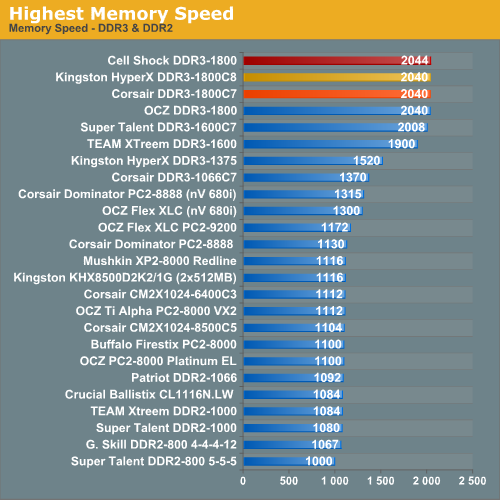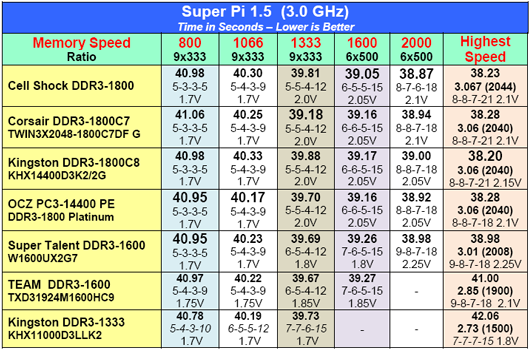Cell Shock, Corsair, and Kingston Introduce Ultra Speed DDR3
by Wesley Fink on October 11, 2007 10:00 PM EST- Posted in
- Memory
Overclocking
We were more than surprised when Super Talent DDR3-1600 topped our overclock charts at DDR3-2008 in late July. A few days later OCZ DDR3-1800 set a new stable overclock record at DDR3-2040. The three new memories based on the same Micron Z9 memory chips matched or slightly exceeded the fastest overclock we have found in testing at AnandTech.

The Kingston DDR3-1800C8 and the Corsair DDR3-1800C7 both top out at DDR3-2040, matching the OCZ DDR3-1800 as the fastest memory tested. Cell Shock 1800 manages one higher FSB with complete stability, with an overclock speed of DDR3-2044. These are all incredible overclocks, with all five memories based on Micron Z9 memory chips exceeding 2000 MHz at the top.
Advances in memory technology are rarely as dramatic as the speed and timing improvements we are seeing with Micron Z9 memory chips. For reference we included our ongoing overclocking chart results for DDR2 just so you can see how significant the new Micron Z9 memory really is. The highest DDR2 we have ever tested reaches DDR2-1315 in an EVGA 680i motherboard. The same memory tops out just above 1100 in our standard DDR2 test bed.
Early DDR3-1066 reached a bit higher than DDR2 such as the typical 1370 achieved with the launch of Corsair DDR3-1066. Timings, however, were somewhat slow. Then the Kingston HyperX pushed 7-7-7 timings all the way to DDR3-1500. Now, just a few months later state-of-the-art DDR3 is reaching DDR3-2000+ at aggressive timings. This kind of progress in memory technology makes the original JEDEC target of 800 to 1600 MHz for DDR3 speeds now appear far too limited.
Even more significant, every new memory tested in this roundup reaches at least DDR3-1950 at fast 7-7-7 timings. The Corsair DDR3-1800 C7 performs best in this test, reaching a stable DDR3-1972 at 7-7-7-18 at 2.15V. This speed far exceeds the specified DDR3-1800 at 7-7-7-21 timings.
Super Pi
In Kingston Launches Low-Latency DDR3 memory performance was compared at 800, 1066, 1333, and highest memory speed. With the introduction of higher speed DDR3 we have added 1600 and 2000 to the standard comparison speeds, if the DDR3 memory is capable of reaching that speed.
To look at pure number crunching, Super Pi 1.5 was run in all memory test configurations. Super Pi is a very simple program as it merely calculates the value of Pi to a designated number of decimal positions. In this case we chose 2 Million places.
Super Pi is fastest (lower value for calc time) on the Kingston DDR3-1800C8, while at 1600 and 2000 the Cell Shock DDR3-1800 is the best performer. Corsair is best at 1333 and OCZ is tops at 800 and 1066. The differences among the five Micron-based memories are extremely small with no clear winner. All the boards are exceptional in their performance.
It is interesting that by 1333 the lower latency DDR3 has completely closed any gap that exists with the fastest timing DDR2, which can run as fast as 3-3-3 timings. Lower latency DDR3 clearly demonstrates you will not have to give up a thing with DDR3 in the overlap speeds and you will gain even more performance at higher speeds as well. The only current roadblock to DDR3 is the high price of admission.
We were more than surprised when Super Talent DDR3-1600 topped our overclock charts at DDR3-2008 in late July. A few days later OCZ DDR3-1800 set a new stable overclock record at DDR3-2040. The three new memories based on the same Micron Z9 memory chips matched or slightly exceeded the fastest overclock we have found in testing at AnandTech.

The Kingston DDR3-1800C8 and the Corsair DDR3-1800C7 both top out at DDR3-2040, matching the OCZ DDR3-1800 as the fastest memory tested. Cell Shock 1800 manages one higher FSB with complete stability, with an overclock speed of DDR3-2044. These are all incredible overclocks, with all five memories based on Micron Z9 memory chips exceeding 2000 MHz at the top.
Advances in memory technology are rarely as dramatic as the speed and timing improvements we are seeing with Micron Z9 memory chips. For reference we included our ongoing overclocking chart results for DDR2 just so you can see how significant the new Micron Z9 memory really is. The highest DDR2 we have ever tested reaches DDR2-1315 in an EVGA 680i motherboard. The same memory tops out just above 1100 in our standard DDR2 test bed.
Early DDR3-1066 reached a bit higher than DDR2 such as the typical 1370 achieved with the launch of Corsair DDR3-1066. Timings, however, were somewhat slow. Then the Kingston HyperX pushed 7-7-7 timings all the way to DDR3-1500. Now, just a few months later state-of-the-art DDR3 is reaching DDR3-2000+ at aggressive timings. This kind of progress in memory technology makes the original JEDEC target of 800 to 1600 MHz for DDR3 speeds now appear far too limited.
Even more significant, every new memory tested in this roundup reaches at least DDR3-1950 at fast 7-7-7 timings. The Corsair DDR3-1800 C7 performs best in this test, reaching a stable DDR3-1972 at 7-7-7-18 at 2.15V. This speed far exceeds the specified DDR3-1800 at 7-7-7-21 timings.
Super Pi
In Kingston Launches Low-Latency DDR3 memory performance was compared at 800, 1066, 1333, and highest memory speed. With the introduction of higher speed DDR3 we have added 1600 and 2000 to the standard comparison speeds, if the DDR3 memory is capable of reaching that speed.
To look at pure number crunching, Super Pi 1.5 was run in all memory test configurations. Super Pi is a very simple program as it merely calculates the value of Pi to a designated number of decimal positions. In this case we chose 2 Million places.
 |
| Click chart to enlarge |
Super Pi is fastest (lower value for calc time) on the Kingston DDR3-1800C8, while at 1600 and 2000 the Cell Shock DDR3-1800 is the best performer. Corsair is best at 1333 and OCZ is tops at 800 and 1066. The differences among the five Micron-based memories are extremely small with no clear winner. All the boards are exceptional in their performance.
It is interesting that by 1333 the lower latency DDR3 has completely closed any gap that exists with the fastest timing DDR2, which can run as fast as 3-3-3 timings. Lower latency DDR3 clearly demonstrates you will not have to give up a thing with DDR3 in the overlap speeds and you will gain even more performance at higher speeds as well. The only current roadblock to DDR3 is the high price of admission.










12 Comments
View All Comments
geok1ng - Thursday, August 28, 2008 - link
looking at http://www.anandtech.com/mb/showdoc.aspx?i=3208&am...">http://www.anandtech.com/mb/showdoc.aspx?i=3208&am... one may wish that an E8600 can reach 10x400Mhz using 2:1 divider + tRD 5 + DDR3 1600 for top notch performance. I look forward for FSB 400/DDR3 1600 CAS 6 examples of memory performance.mandos9 - Tuesday, November 6, 2007 - link
"The recent performance improvements in DDR3 memory have far exceeded anything the end user or industry expected to see in such a short period of time. "The performance improvement is,in comparison to ddr2,5-7fps.That's almost nothing,especially when the games you test already run at 100+ fps(why don't you test it on the crysis demo or games that have come out more recently?).
I don't see why i should spend 600(or 300 for that matter) euro to upgrade my pc, when i can buy a second 8800GT for 250 euro and get 30 or more fps.
Nobody would buy ddr3 for performance. I can only see me buying it if i want a new mobo which i will not have to replace in a year or two.
nrb - Monday, October 15, 2007 - link
Oh joy, yet another anandtech article where I can't see any of the graphs. How many more years are you guys going to allow this to go on?(sigh)
Wesley Fink - Monday, October 15, 2007 - link
The charts are all there. We can read them fine in IE and Firefox. I just double-chescked to make sure there are no broken links. Can you please let us know what you are using as a browser?DrMrLordX - Saturday, October 13, 2007 - link
Why have you not included latency numbers as measured in cycles and/or nanoseconds?goinginstyle - Friday, October 12, 2007 - link
Do you think we could see a DDR2 memory review? Only about 90% of the desktop systems released in the last couple of years use it and considering the unbelievably low prices now it would be nice to see a review of memory that people actually use. It is getting boring to see $650~$900 memory reviewed when most of us cannot even begin to think about buying it or even can afford it if we wanted to change. Show us some results on memory that most people use now.Wesley Fink - Monday, October 15, 2007 - link
The Kingston DDR3, which performed at the top of our test results, has a MSRP of $450 for the 2GB kit - NOT 650-900. It is still much higher than DDR2 but prices are starting to come down.We do have a DDR2 roundup coming in the near future. However, if you look back at the DDR2 review you will find many of the currently available DDR2 memory has been reviewed at AT before the introduction of DDR3.
retrospooty - Friday, October 12, 2007 - link
at DDR 2000 at 6X500 CPU the best sisoft standard memory score for DDR3 is 9138 at DDR3 2000 8-7-6-18 ... I get 8871 with my DDR2 1000mhz at 4-4-4-10 with a similar setup on a DFI P35 mobo.Thats a lot of cash for an extra 267 mb per second bandwidth. Granted my memory setting are highly tuned, but the speed difference is even smaller than I had imagined. I would say the "dramatic" speed increases are totally crippled by the "dramatic" latency penalties. Hopefully in a year or 2 we will see some lower latencies.
Wesley Fink - Monday, October 15, 2007 - link
Congratulations on your great Buffered bandwidth scores with DDR2. We use a standardized setup and do not really tweak timings as you have. Any of our test results can ge tweaked to produce much higher test results, so it is best to compare apples to apples.At 1066 our DDR3 at 5-4-3-9 timings is an Sandra bandwidth of 6763, while you get 8871, a difference of 2100+. We are confident we could tweak the 1066 timings to pick up the 2100 points since the latest DDR-3 based on Z9 chips is testing equal or faster than the fastest DDR2 at the same speed at 1066 or above. That means DDR3-2000 could be 2300+ higher when tweaked for top bandwidth. In addition the fastest possible BIOS timings at 1066 with DDR3 are 5-3-3-5, and we are not far from that.
If you check some enthusiast postings where they tweak the DDR3 for bandwidth you will find bandwidths exceeding 11000 on Sandra with Z9 based dimms. I suspect you already know this.
Anonymous Freak - Thursday, October 11, 2007 - link
At the top of each page of the article is the list of places to buy:That's all well and good. But the last four are the same company. (Ritz Camera owns Wolf, Camera World, and PhotoAlley.)